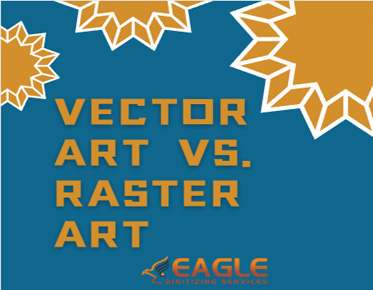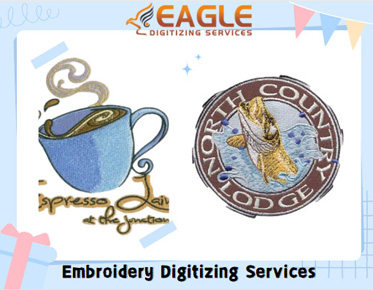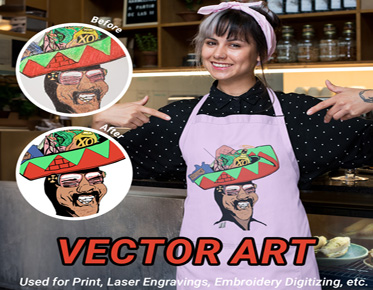Vector Art vs. Raster: Which Format is Right for Your Project?
In the world of digital design, the choice between vector art and raster images can significantly impact the outcome of your project. Both formats have their strengths and weaknesses, making it crucial to understand their differences and applications. In this article, we'll delve into the intricacies of vector art and raster images, exploring their characteristics, advantages, common applications, and factors to consider when deciding which format suits your project best.
● Suitability for
Different Projects
● Compatibility
with Software and Devices
● Tips for Choosing
the Right Format
Definition
and Characteristics
Vector art is composed of mathematical equations rather than individual pixels. This means that regardless of size or scale, vector images maintain their crispness and clarity. They are defined by lines and curves, allowing for smooth edges and infinite scalability without loss of quality.
Advantages
One of the primary advantages of vector art is its scalability. Whether you're designing a small logo or a large billboard, vector images can be resized without sacrificing quality. Additionally, they are ideal for illustrations, logos, and designs that require precise lines and shapes.
Common
Applications
Vector art finds extensive use in various industries, including graphic design, branding, and signage. It's particularly well-suited for creating logos, icons, typography, and illustrations that need to be resized or scaled for different purposes.
Definition
and Characteristics
Unlike vector art, raster images are composed of a grid of pixels, each with its own color value. These images are resolution-dependent, meaning that enlarging them can result in a loss of quality and pixelation. Common raster file formats include JPEG, PNG, and TIFF.
Advantages
Raster images excel at capturing complex details and photographic realism. They are the preferred format for photographs and digital paintings where subtle color variations and intricate details are essential.
Common
Applications
Raster images are widely used in photography, digital art, and web design. They are suitable for projects where precise scalability is not a priority, such as website graphics, social media posts, and digital illustrations.
Complexity
of Design
When choosing between vector art and raster images, consider the complexity of your design. Vector art is better suited for simple, geometric shapes, while raster images excel at capturing intricate details and textures.
Scalability
If your project requires resizing or scaling the image without compromising quality, vector art is the superior choice. Raster images may become pixelated when enlarged, making them less suitable for applications where scalability is crucial.
Editing
Flexibility
Vector art offers unparalleled editing flexibility, allowing designers to modify individual elements, adjust colors, and manipulate shapes with ease. Raster images, on the other hand, are more limited in terms of editing options and may lose quality when altered extensively.
File
Size
Raster images tend to have larger file sizes compared to vector art, especially at higher resolutions. This can impact storage space and website loading times, making file size an important consideration when choosing between the two formats.
Resolution
Vector art maintains consistent quality regardless of resolution, making it ideal for projects that require high-definition imagery. Raster images, on the other hand, are resolution-dependent and may appear pixelated when viewed at higher resolutions.
Clarity
and Sharpness
Due to their mathematical precision, vector images are inherently sharper and clearer than raster images, especially when scaled or resized. Raster images may lose clarity and sharpness when enlarged beyond their original size.
Enlargement
Vector art can be enlarged infinitely without losing quality, making it the preferred choice for projects that require resizing or scaling. Raster images, however, may become pixelated and lose detail when enlarged, limiting their suitability for large-format printing or scaling.
Print
Materials
For projects involving print materials such as brochures, posters, and business cards, vector art is often the preferred format due to its scalability and high-quality output.
Web
Graphics
Raster images are commonly used for web graphics, including website banners, product images, and blog posts. Their smaller file sizes make them more suitable for online use, where fast loading times are essential.
Logo
Design
Vector art is the go-to format for logo design due to its scalability and flexibility. Logos created in vector format can be easily resized for various applications, ensuring consistent branding across different platforms.
Design
Software
Both vector art and raster images are compatible with a wide range of design software, including Adobe Illustrator, Photoshop, and CorelDRAW. Designers can choose the format that best suits their workflow and project requirements.
Printing
Devices
Vector art is compatible with virtually all printing devices and ensures high-quality output, regardless of the printing method used. Raster images may require higher resolutions for optimal printing quality, especially for large-format prints.
Display
Devices
Raster images are commonly used for display devices such as computer monitors, smartphones, and tablets. Their pixel-based nature makes them well-suited for digital screens, where resolution and color accuracy are paramount.
Production
Costs
Vector art and raster images may incur different production costs depending on the complexity of the project and the desired output. Vector art may require more time and skill to create initially but can result in cost savings in the long run due to its scalability and versatility.
Licensing
Fees
Some stock image libraries may charge different licensing fees for vector art and raster images. Consider your budget and licensing requirements when choosing the format for your project.
Storage
Costs
Raster images generally have larger file sizes compared to vector art, which can impact storage costs, especially for projects with extensive image libraries. Consider your storage capacity and requirements when deciding between the two formats.
Assess
Project Requirements
Before choosing between vector art and raster images, carefully assess your project requirements, including scalability, editing flexibility, and output quality.
Consider
Future Needs
Consider the future needs of your project, such as potential resizing or scalability requirements. Choosing the right format from the outset can save time and resources down the line.
Consult
with Design Professionals
If you're unsure about which format is best for your project, consider consulting with design professionals who can provide expert advice and guidance based on your specific needs and objectives.
Choosing between vector artwork and raster images
can be a daunting task, but understanding the differences and applications of
each format can help you make an informed decision. Whether you're creating
print materials, web graphics, or logos, consider the scalability, editing
flexibility, and image quality required for your project to determine the right
format for your needs.



